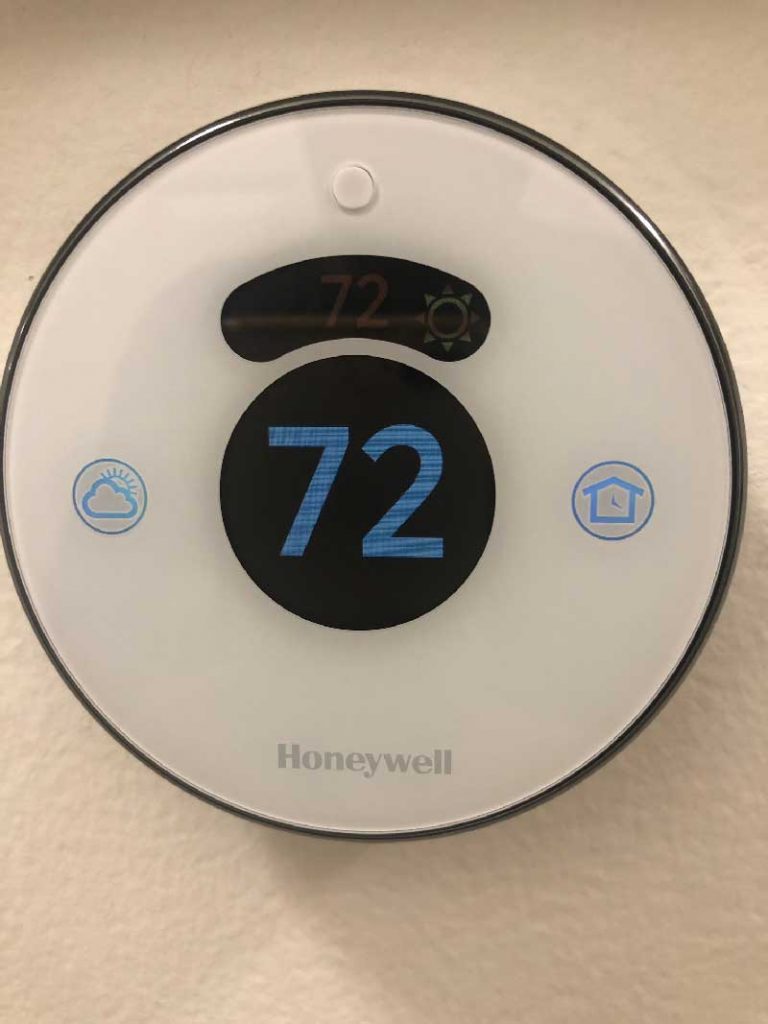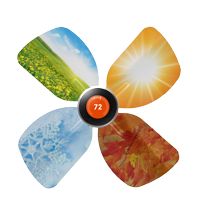A thermostat is a device that is used to regulate the temperature of an environment, such as a room or a building.
It is a common feature in many homes and buildings and is used to maintain a comfortable temperature range throughout the day and night.
In this article, we will take a closer look at what a thermostat is, how it works, and how it controls HVAC (heating, ventilation, and air conditioning) systems.

What is a Thermostat?
At its core, a thermostat is a temperature-sensitive switch that is designed to turn on or off heating or cooling systems in order to maintain a desired temperature range.
In other words, it is a device that can detect changes in temperature and use that information to control the operation of a heating or cooling system.
A basic thermostat consists of a temperature sensor, a control unit, and a switch. The temperature sensor is typically a bimetallic strip, which is made up of two different metals with different thermal expansion rates.
As the temperature changes, the strip will expand or contract, causing it to bend or straighten out.
The control unit is responsible for processing the information from the temperature sensor and using it to determine whether the heating or cooling system needs to be turned on or off.
If the temperature is too low, the control unit will activate the heating system, and if the temperature is too high, it will activate the cooling system.
The switch is used to turn the heating or cooling system on or off based on the information received from the control unit.
How Does a Thermostat Work?
The exact operation of a thermostat will depend on the specific type and model being used. However, there are a few basic principles that are common to most thermostats.
First, the controller must be installed in a location where it can accurately measure the temperature of the environment it is regulating.
This may be in a hallway, a living room, or any other area where temperature fluctuations are likely to occur.
Once installed, the controller will typically be set to a desired temperature range, which can be adjusted by the user as needed.
The control unit will then use the temperature readings from the temperature sensor to determine whether the heating or cooling system needs to be turned on or off.
When the temperature drops below the desired range, the thermostat will activate the heating system. This could be a furnace, a boiler, or any other type of heating system.
The switch in the controller will close, completing an electrical circuit and sending a signal to the heating system to turn on.
As the heating system operates, it will gradually raise the temperature of the environment.
Once the temperature reaches the desired range, the thermostat will turn off the heating system by opening the switch, breaking the electrical circuit, and stopping the flow of power to the heating system.
If the temperature rises above the desired range, the same process will occur, but with the cooling system instead of the heating system.
The thermostat will activate the cooling system, which could be an air conditioner or a heat pump.
The switch in the thermostat will close, completing an electrical circuit and sending a signal to the cooling system to turn on.
As the cooling system operates, it will gradually lower the temperature of the environment.
Once the temperature reaches the desired range, the thermostat will turn off the cooling system by opening the switch, breaking the electrical circuit, and stopping the flow of power to the cooling system.
How Does a Thermostat Control HVAC Systems?
Thermostats are an essential component of HVAC systems, as they are used to control the operation of heating, ventilation, and air conditioning systems.
HVAC systems are designed to maintain a comfortable temperature range in a building or home, while also ensuring proper air circulation and filtration.
When it comes to HVAC systems, thermostats can be divided into two main categories: standalone thermostats and programmable thermostats.
Standalone thermostats are the most basic type of thermostat, and they are used to control the operation of heating and cooling systems manually.
These thermostats typically consist of a temperature sensor and a switch, and they must be adjusted manually by the user to maintain the desired temperature range.
Programmable thermostats, on the other hand, are designed to automatically adjust the temperature based on a pre-set schedule.
These thermostats can be programmed to adjust the temperature based on the time of day, day of the week, or even specific events, such as vacations or holidays.
Programmable thermostats are often more energy-efficient than standalone thermostats, as they can be programmed to reduce heating or cooling during times when no one is home or during times when the temperature can be allowed to fluctuate more. This can result in significant energy savings over time.
In addition to standalone and programmable thermostats, there are also smart thermostats, which are designed to connect to the internet and be controlled remotely using a smartphone app or voice commands.
Smart thermostats can provide even more control over HVAC systems, allowing users to adjust the temperature and monitor energy usage from anywhere.
Smart thermostats can also be programmed to learn the user’s preferences over time, automatically adjusting the temperature based on patterns in the user’s behavior. This can help to further improve energy efficiency and comfort.
Overall, thermostats play an essential role in the operation of HVAC systems. Whether you are using a standalone thermostat, a programmable thermostat, or a smart thermostat, these devices are designed to maintain a comfortable temperature range in your home or building while also ensuring proper air circulation and filtration.
By using a thermostat to control your HVAC system, you can improve energy efficiency, save money on your utility bills, and enjoy greater comfort and convenience.
Feel free to contact Any Season Heating & Cooling today at 847-766-9654 for all your heating and air conditioning service needs.
Schedule an HVAC appointment for your central air conditioning & heating service, repair, maintenance, or replacement.
HVAC Near Me | HVAC Contractor Near Me
Follow Us on Social Media: Google Maps | Facebook | Twitter | LinkedIn | Facebook



One Reply to “What is a thermostat and how does it controls HVAC systems?”
Unveiling the Truth About Air Conditioning: Debunking 10 Common Myths - Any Season Heating & Cooling Inc.
[…] It’s better to adjust the temperature a few degrees higher when you’re away. Modern thermostats can quickly restore the desired temperature when you return, conserving energy while you’re […]
Comments are closed.